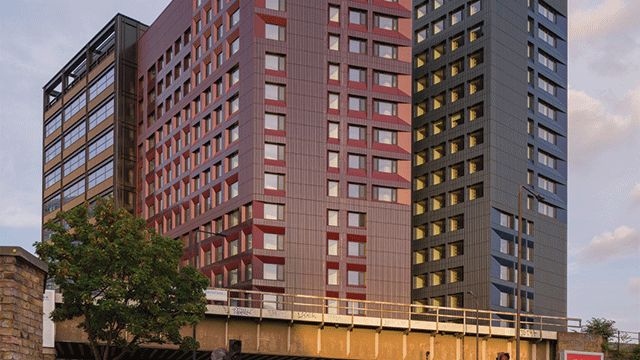Moving on: Floating cargo ports and robot warehouse staff are some of the visionary ideas being pursued in the industrial sector
Predicting the future is a notoriously risky business, as the then-chairman of IBM, Thomas Watson, found in 1943 when he infamously declared that there would only ever be “a world market for about five computers”.
Retailers have long imagined a utopian future without a single logistics warehouse, where advanced technology would shuttle goods automatically from factory to shop floor, or even from factory floor to living room. Instead, however, the opposite has become true. Like the personal computer, sheds have proliferated and have become ubiquitous and more innovative. And their designers continue to push into the realms of science fiction.
For occupiers
From Buck Rogers in the 25th Century to Star Wars, robot companions are a sci-fi mainstay, but one US company wants to make them an everyday part of warehouse life. Kiva Systems’ robots may look like squat R2-D2s clad in bright orange, but they are programmed to behave like worker ants, performing complex tasks with only limited central control.
Kiva chief executive Mick Mountz says that his innovation was sparked by a simple question: “What if all the products in the warehouse could walk and talk on their own? Couldn’t they just come to me when I need to fill an order?”
So his robots pick items off the warehouse shelves as soon as an order is made, bringing them to a central packing area. They adapt to fluctuating demand by making more popular items more accessible, and even help to reorder stock.
The Ohio-based company’s vision is for a fully automated warehouse. It sold its 1,000th robot in April and claims that the combined distance travelled by its legion of automatons as they store, move and sort packages would stretch far beyond the Moon.
Of course, humans are not obsolete yet, but software engineer Pete Wurman says that Kiva anticipates “larger and larger implementations with virtually no limit to scale-up capacity”.
For example, in two US warehouses where stationery supplier Staples has deployed the Kiva Mobile Fulfilment System, the company says that its army of bots is filling up to three times as many orders as was previously achieved.
“Kiva Systems is both a pioneer and the leader in large-scale, commercial robotic implementations,” says Dan Kara, president of Robotics Trends magazine. “While other robotics companies offer single-robot applications, Kiva has broken the mould by successfully deploying hundreds of robots in a single, viable commercial application that is rewriting the rules for competitive retail fulfilment systems.”
Green advances
Until the vision of a workerless warehouse is achieved, other innovations are emerging as the green agenda – and particularly Energy Performance Certificates, which give ratings from A to G for energy use – continue to push technological boundaries. Lighting systems are a case in point, with traditional high-intensity discharge lights rapidly becoming obsolete.
As evidence, Somar International’s new Powerboss Eluma scooped the UK Warehouse Association’s Technology/Innovation of the Year Award in 2007. Somar claims that its new light can save 60% to 80% of a building’s lighting costs, which can comprise 50% to 75% of the total energy bill. It does this by employing motion sensors to turn lights on and off, and it can also detect and respond to changes in ambient light.
The Eluma “intelligent lighting fixture” replaces lights that use metal halide or high-pressure sodium. Such lights take as long as 10 minutes to produce full illumination so they tend to be left on continually, and they cannot be dimmed. As a result, generating the power used to run one 400W HID light all year creates 1.7 tonnes of CO2.
Warehouses may not yet be zero-carbon-rated, but a vision of logistics hubs that are net energy producers is being pursued by industrial developer Gazeley. And technological advances are helping occupiers to keep pace. For example, CO2 refrigeration is now increasingly used to help keep consumer goods such as ice-cream, frozen foods and meat cool.
In the past year, UK engineering company Star Refrigeration has installed a £3m refrigeration plant in supermarket giant ASDA’s distribution centre at Gazeley’s Magna Park, Lutterworth, Leicestershire. The ammonia and CO2 cascade plant has six times the cooling capacity of conventional systems.
Although the technology is not new, Brixton’s X2 in Hatton Cross, west London, last month became the first multi-storey, fully accessible warehouse in the UK. And if UK occupiers show that they have the same head for heights as their counterparts in Japan and Singapore, the 242,000 sq ft distribution centre could become the first of many to build skywards.
But the green agenda offers innovations other than height.
For example, the makers of photovoltaic cells (PVs) confidently predict a future featuring inflatable sheds made from ethylene tetrafluoroethylene (ETFE), a strong plastic polymer similar to Teflon. UK-based company Solar Century believes that PVs can be encapsulated into the skin of ETFE cushions to create inflatable industrial buildings that generate their own electricity, and foresees a trend toward buildings that are inflatable rather than steel-framed.
Roof innovation
Although such a product may be some way off, Gazeley’s flagship development, the 500,000 sq ft Chatterley Valley scheme in Newcastle-under-Lyme, north Staffordshire, will boast the UK’s most innovative warehouse roof – an inflatable cushion of ETFE roof plates fitted with thin-film PVs. Work on the £50m scheme – which deploys other technological advances including kinetic plates that capture energy every time a vehicle enters or leaves the site – will start this year.
Also on site in 2008 is ProLogis’s flagship design for its 2.1m sq ft rail-connected development at Howbury Park in Erith, Kent, which boasts an overall energy reduction of 85% compared with conventional shed design. The roof, which features PV panels, is of a space-saving “cable stay” design similar to that used on the Millennium Dome – this uses 20% less steel and therefore lowers the amount of CO2 released in its manufacture.
ProLogis has pledged that its future UK developments would achieve a minimum “Very Good” rating under the BRE’s Environmental Assessment Method.
Ken Hall, the company’s managing director of global development, says: “Gone are the days when one could build an average building that met building regulations, and then put a few PVs and wind turbines on the outside. It is a lot more sophisticated now. The whole vocabulary of the marketplace has changed, which is very welcome because it introduces some way to measure what a sustainable building is.”
This market shift has prompted steelmaker Corus to develop a range of zero-carbon products, now used by ProLogis among others, which employ carbon offsets to offer a zero-carbon building shell. “Five years ago,” Hall says, “it was beyond anybody’s understanding that the supply chain could do that.”
A floating port
Space constraints have been an issue in UK ports for years, and the issue is a growing concern in Europe. Could a floating port be the answer?
One consequence of the worldwide war on terrorism is that plans for vast floating ports that can process millions of tonnes of cargo have been pushed back onto industry’s radar. Previously thought too expensive and impractical, the idea has resurfaced amid concerns over port security and, especially, the desire of US officials to push customs controls off dry land.
In calm waters, small barges can be used as floating docks, but they have little capacity. On the open seas, semi-submersible structures are used to float oilrigs, but they cost as much as £30m per acre. However, Float Incorporated, a US company that manufactures building blocks for “floating real estate”, says that its pneumatically stabilised platform technology can overcome such problems.
Ships typically carry 4,000-6,600 TEUs (20ft equivalent units – a measure of container capacity) but a new generation of larger cargo ships is being built to carry 12,000 TEUs. However, a paper by Float Inc warns that this will put pressure on onshore harbours. It says: “The ports of the world will bear the brunt of expensive modifications to service the shipping industry. Many ports have little or no additional room for this expansion.”
The UK’s Department for Transport forecasts that, by 2030, containerised port traffic will increase by 183% to 20m TEUs. In a 2007 paper, it warned: “An absence of additional GB deep water container port capacity would raise user costs, reduce GB transport revenue, and add to road freight and external costs. A need for an extensive expansion in the number of feeder berths would emerge, for which plans do not exist. The impact on the economy was negative, raising end-user costs.”
The major retailers and manufacturers, which rely on shipping lines to transport cargo, believe that these higher costs are being felt now. And the British Shippers’ Council says that, while welcome, new developments at major container terminals, such as PD Ports in Teesside and DP World’s London Gateway, will cater for this growth but will not address the chronic lack of capacity at UK ports.
“It is a huge problem for us,” says spokesman Chris Snelling. “All of our ports are congested, but particularly in the North Sea and the [English] Channel. The problem is deep-sea capacity, and we are increasingly seeing cargo ships from the Far East pass us by. The UK is losing ‘port of call’ status.”
He adds: “This delays things for weeks, if not months. Some big ships unload in Rotterdam instead and get goods get shipped to the UK. It adds time, cost and unreliability.”
Despite talk of floating ports, the British Chamber of Shipping is more prosaic in its demands.
“Two things need to happen,” says shipping policy officer Tim Reardon. “The expansion of the ports themselves, and the provision of better land-side connections to UK container terminals: larger roads and more railways.”
He adds: “We want a more facilitative rather than obstructive planning process. People are willing to build ports and to put up new money to invest in the construction of new ports. What is standing in their way is the planning.”
Both the BSC and the BCS back the creation of an independent planning commission to lift major infrastructure projects such as ports out of the planning system in the planning reform bill, which could become law next year. If that happens, extra capacity could be built on dry land, rather than at sea.










